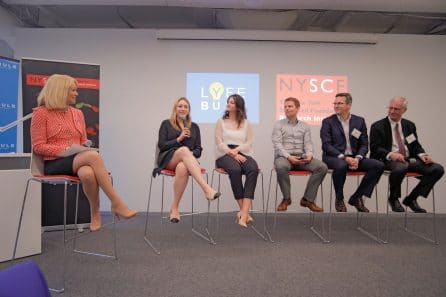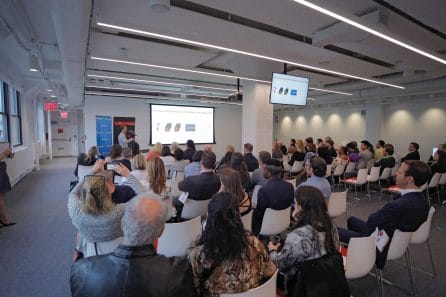Taking on Type 1 Diabetes: Researchers and Patient Advocates Unite in the Quest for a Cure
News Video“I got involved in type one diabetes advocacy over 25 years ago when my son was diagnosed,” said NYSCF CEO Susan L. Solomon, JD. “At that time, we were told, ‘This is difficult but not a problem. A cure is 10 years away.’ Well, that was a while ago. Here we are, and unfortunately, we still don’t have a cure.”
This stagnation of progress in medical research was what inspired Ms. Solomon to start the New York Stem Cell Foundation (NYSCF), whose dedication to studying type 1 diabetes (T1D) and other devastating diseases in human cells derived from patients is accelerating research toward cures. At a recent panel discussion held at NYSCF headquarters and co-hosted with Lyfebulb, T1D researchers, physicians, and patient advocates discussed how these communities can work together to provide patients with a brighter future.
The discussion was moderated by Lyfebulb CEO Karin Hehenberger, MD, PhD, and featured diabetic health coach Lauren Bongiorno, NYSCF Senior Research Investigator Bjarki Johannesson, PhD, JDRF President and CEO Aaron Kowalski, PhD, Be Mixed Co-founder Jennifer Ross, and Clinical Assistant Professor at the NYU School of Medicine Stuart Weiss, MD. Apart from Dr. Johannesson, all of the panelists are type 1 diabetics themselves, and they spoke about how their experiences with the disease have informed their work in diabetes research and advocacy.
The Toll of T1D
In T1D, the immune system makes a mistake: it attacks healthy pancreatic beta cells—the cells that produce insulin. Insulin helps the body absorb glucose from the bloodstream, and when it is absent, blood sugar levels can become dangerously high, affecting virtually all tissues in the body.
Because of this, T1D patients are tasked with regulating their own insulin, often through injections they administer themselves. But this process is tedious, and for many patients, all-consuming.
Ms. Ross and Ms. Bongiorno have dedicated their careers to helping quell the stress of managing a chronic disease in fellow T1D patients.

“I thought about what I could do that would help myself and others, and that’s why we developed Be Mixed, our line of sugar-free cocktail mixers,” explained Ms. Ross. “Because for those celebratory moments, we wanted to create something that everyone can enjoy.”
Ms. Bongiorno remembers the peak of her T1D anxiety. It happened during a visit to her endocrinologist in college. Her blood sugar levels were great, but she didn’t feel great.
“I feel like an anxious mess,” she remembered thinking. “I have the worst relationship with food. I’m afraid of carbs. I literally eat and then I go and exercise right after. My whole life is diabetes.”
As a diabetic health coach, Ms. Bongiorno helps her clients develop positive behaviors that keep them on top of their disease without letting it overwhelm them.
“It’s easy for type ones to be in a reactive state versus a proactive state,” remarked Ms. Bongiorno. “I coach people to start looking at their own patterns and doing the work outside the endocrinologist’s office.”
This type of patient-driven innovation is what Lyfebulb strives to promote. Dr. Hehenberger established Lyfebulb as a platform for patients to support each other and bring attention to the issues that they find most pressing. Lyfebulb also shares NYSCF’s mission of finding cures, and Dr. Hehenberger expressed her excitement to collaborate with a community focused on eliminating the disease once and for all.
“It feels very good to be partnering with an organization that is focused on cures,” said Dr. Hehenberger. “We are here to find better ways to live with diseases that are chronic and to find better treatments, but finding the cure is really the ultimate goal.”
The Road to a Cure
In addition to establishing ways to help patients overcome T1D’s physical and mental consequences, we need better options that allow patients to live their lives without the constant pressure of managing a chronic disease. NYSCF Senior Research Investigator Dr. Bjarki Johannsson believes stem cells are the key to getting us there.
Dr. Johannesson’s research uses stem cells to create beta cells from T1D patients. He then uses these beta cells to study the disease’s mechanisms, test drugs, and develop new treatments. With NYSCF’s state-of-the-art robotic platforms such as the NYSCF Global Stem Cell Array®, this process can move at an accelerated pace—allowing Dr. Johannesson’s team to create beta cells on a large scale and test hundreds of drugs in a short period of time.

He is most excited about the prospect of using stem cells to generate personalized, healthy beta cells for cell replacement therapies. In these therapies, the beta cells generated from patient stem cells (and engineered to become functional again) would simply take the place of the dying ones.
“Cell replacement therapy is not such an incredibly distant future. We are almost there in the sense that we can generate cells that are high enough quality to start thinking about putting them into humans,” remarked Dr. Johannesson.
One important issue is that even if we can generate healthy beta cells for replacement, we still need to protect them from autoimmune attack.
“Using a new technology called genome editing, we’re able to modify and delete genes that we think are critical for the process of being recognized by the immune system,” Dr. Johannesson explained.
These edited cells essentially camouflage themselves from the immune system, shielding them from destruction so they can continue to secrete insulin, keeping patients healthy in the long term.
Dr. Weiss has been seeing patients with T1D for decades, and while he is happy with many of the advancements he has seen over the years, he is still hopeful for a more permanent solution.

“The future is in the development of these technologies that will make it so that patients don’t have to be continuously conscientious about controlling what they’re doing. I don’t want to be 90 years old and having to check my blood sugar.”
Dr. Kowalski also expressed his excitement for the possibility of therapies that address the root cause of the disease and highlighted the need for additional measures aimed at prevention.
“I think the thing that I worry a lot about is my kids,” he remarked. “The risk in New York City for developing T1D is 1 in 300. The risk for my kids is 10%. I think not enough people appreciate, especially in the clinical community, is that there’s this increased risk for the next generation and we need to look at preventative therapies.”
The only way we can achieve these goals is if we work together. Ms. Solomon is optimistic that widespread collaboration will be what finally brings us to a cure for T1D.
“It takes advocates; it takes doctors; it takes researchers; it takes funders. This beautiful mosaic of groups has to work together in order to achieve the goal.”
Learn more about NYSCF’s diabetes research here.
Watch highlights of the panel discussion below.